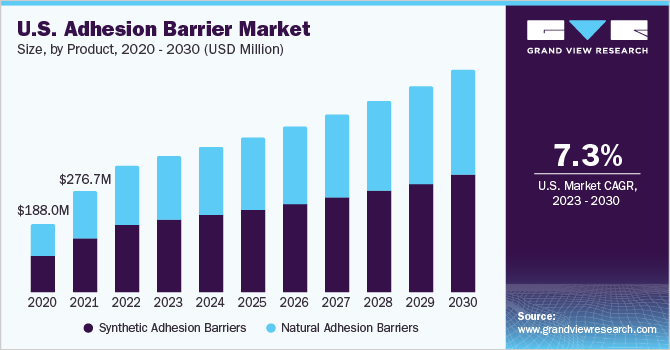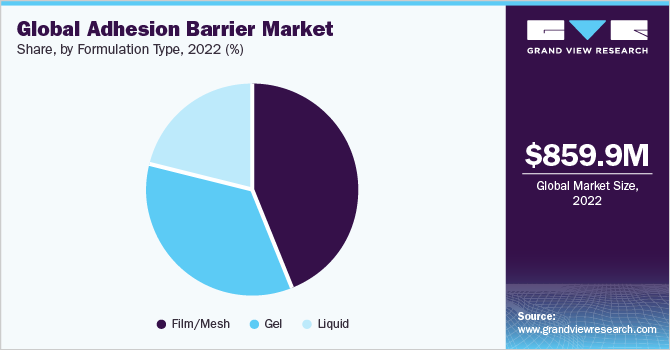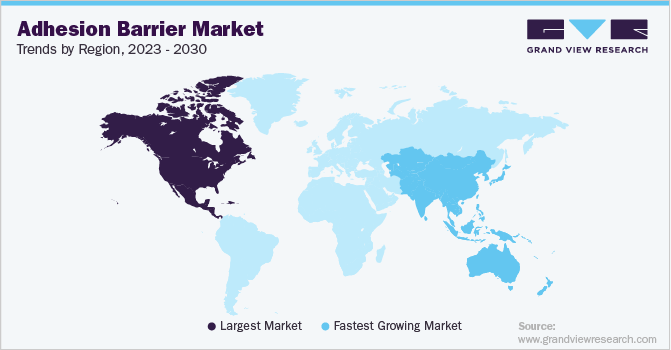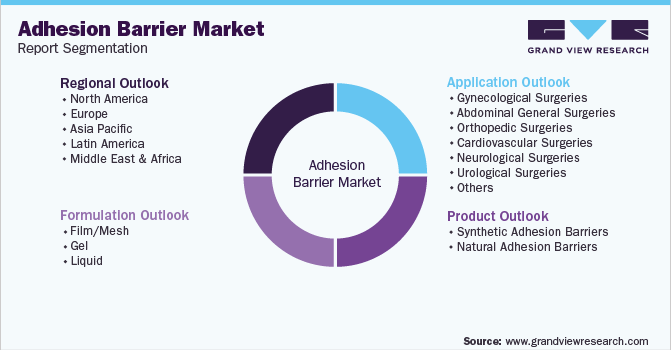- Home
- »
- Medical Devices
- »
-
Adhesion Barrier Market Size & Trends Analysis Report, 2030GVR Report cover
![Adhesion Barrier Market Size, Share & Trends Report]()
Adhesion Barrier Market (2023 - 2030) Size, Share & Trends Analysis Report By Product (Synthetic, Natural), By Formulation (Film/Mesh, Gel), By Application (Cardiovascular, Neurological Surgery), By Region And Segment Forecasts
- Report ID: GVR-2-68038-545-8
- Number of Report Pages: 140
- Format: PDF
- Historical Range: 2018 - 2021
- Forecast Period: 2023 - 2030
- Industry: Healthcare
- Report Summary
- Table of Contents
- Segmentation
- Methodology
- Download FREE Sample
-
Download Sample Report
Adhesion Barrier Market Summary
The global adhesion barrier market size was valued at USD 859.95 million in 2022 and is projected to reach USD 1.50 billion by 2030, growing at a CAGR of 7.3% from 2023 to 2030. The key drivers of the market are the rising geriatric population coupled with the increasing number of surgical procedures.
Key Market Trends & Insights
- The North America region dominated the market and accounted for the largest revenue share in 2022.
- Based on product, he Synthetic adhesion barrier accounted for the largest market size in 2022.
- Based on formulation, the film/mesh segment dominated the market and accounted for the largest market share in 2022.
- Based on application, the cardiovascular surgeries segment dominated the market in 2022.
Market Size & Forecast
- 2022 Market Size: USD 859.95 Million
- 2030 Projected Market Size: USD 1.50 Billion
- CAGR (2023 to 2030): 7.3%
- North America: Largest market in 2022
The surging frequency of invasive surgeries with a high risk of postoperative complications is anticipated to trigger market growth. However, with the rising risk of post-operation adhesion, the market is still witnessing barrier in terms of accessibility, lack of health education, and lack of awareness about the importance of treatment.
The adhesion barrier market is expected to see significant growth due to a few key factors. The improvement in healthcare infrastructure and the increasing availability of trauma care centers will drive the market forward. Additionally, the growing incidence of sports-related injuries is also expected to contribute to the growth of the market. Recent data from Stanford Children's Health shows that out of the approximately 30 million children who participate in some form of sports, over 10% experience injuries each year.
Also, the British Heart Foundation estimates that 32,938 completed heart surgeries and other heart procedures were carried out in England in just the month of October 2021. The rising frequency of operations and surgeries is anticipated to increase demand for adhesion barrier, further boosting market expansion. Adhesion barrier are frequently used after surgeries to lessen scars and avoid adhesions.
The adhesion barrier market is seeing growth due to several factors. Rising healthcare expenditure, along with increased FDA approval for various adhesion barrier products, is contributing to the market's expansion. For instance, Ethicon, Inc., a subsidiary of Johnson & Johnson, received FDA clearance for its VISTASEAL Fibrin Sealant (Human) product in November 2020. This product is designed to be used as an adjunct to hemostasis during surgery, to reduce the incidence of postoperative adhesions.
The FDA's approval of this product is just one example of how innovation and advancements in medical technology are driving growth in the advanced adhesion barrier market. As companies continue to develop new and improved products that can help prevent postoperative adhesions, we can expect to see increased demand for these products.
Product Insights
The Synthetic adhesion barrier accounted for the largest market size owing to high bioresorbable and biocompatibility. Synthetic adhesion barriers are cost-effective which is expected to increase sales of the segment. Moreover, the dominance of the segment is primarily attributed to the availability of commercial synthetic adhesion barrier. The segment is further divided into hyaluronic acid, regenerated cellulose, polyethylene glycol, and others. The hyaluronic acid segment dominates, owing to its capacity to attract and hold a vast amount of moisture.
Natural adhesion barrier segment also accounted for a considerable market share in 2022 and is expected to grow at a lucrative rate during the forecast period. The segment is further divided into collagen & protein, and fibrin. Collagen & protein segment held the largest market size owing to its benefits such as durability and safety. The fibrin segment is expected to grow at a rapid pace during the forecast period. The high growth rate of the fibrin segment is primarily attributed to the rising adoption of these products
Formulation Insights
The film/mesh segment dominated the market and accounted for the largest market share in 2022 and is expected to maintain its dominance during the forecast period. The large share of the segment is primarily attributed to its low cost and increasing use of film form adhesion in various surgeries. In addition, many clinical evidence are supporting the efficiency and safety of these forms of adhesion, thus, adding growth to the market growth.

Gel is expected to grow at the fastest rate during the forecast period. The high growth rate of the segment is primarily attributed to its advantages such as affordability, resorbability, easy application, and safety. Moreover, increasing usage of gels in various surgeries such as tendon, carpal tunnel, and joint or peripheral surgery is expected to expand its applications in upcoming years.
Application Insights
The cardiovascular surgeries segment dominated the market and is expected to grow at the fastest CAGR during the forecast period. The rising incidence of heart-related diseases and the increasing use of adhesion barrier in cardiovascular surgeries are the main drivers of growth in this segment of the advanced adhesion barrier market. A recent study published in the Annals of Medicine and Surgery in 2020 found that adhesion barriers are also beneficial in preventing the formation of peristomal adhesion. This highlights the versatility of adhesion barrier and their potential to improve patient outcomes in a variety of surgical procedures.
Gynecological surgery segment held the largest market share in 2022 and is expected to maintain its dominance during the forecast period. Market dominance is primarily attributed to a rising number of gynecologic laparoscopy procedures. Furthermore, increasing the adoption of gel form and film form in various gynecological procedures including endometriosis surgery, ovarian cystectomy, and ectopic pregnancy are boosting the market growth. Slow adoption of minimally invasive techniques in developing countries is expected to have a positive impact on the adoption of adhesion barrier. Minimally invasive surgeries require high priced equipment such as cameras and robot-assisted devices. Adoption of these devices is expected to be moderate in developing countries because of price sensitive customers.
Regional Insights
North America region dominated the adhesion barrier market and accounted for the largest revenue share in 2022. The market owing to the presence of major players such as Johnson & Johnson, Baxter International, Integra LifeSciences, Anika Therapeutics, and FzioMed. Increase in the prevalence of orthopedic conditions coupled with the high adoption of advanced treatment procedures is anticipated to fuel the market growth in the U.S.

Asia Pacific adhesive barrier market is expected to grow at a lucrative rate over the forecast period. The high growth rate in the region is primarily attributed to the rising geriatric population and increasing incidence of cardiac and neurosurgery which require surgical interventions. Moreover, rising private sector investment in healthcare and rapidly expanding medical tourism are expected to drive the growth of the adhesion barrier market in the region. Major countries such as India, China, and Japan are expected to contribute maximum growth to the region during the forecast period.
Adhesion Barrier Market Share Insights
To maintain market share, many players in the advanced adhesion barrier market are adopting strategies such as increasing product launches, mergers & acquisitions, partnerships, and technological collaborations. For instance, In 2022 Gunze announced the launch of the TENALEAF absorbable adhesion barrier in Japan. This strategic move is helping the company to expand its product portfolios and improve its market presence, which is essential in this highly competitive market. Some of the key players in the global adhesion barrier market include:
-
Sanofi S.A.
-
Becton Dickinson and Company
-
Baxter International, Inc.
-
Johnson & Johnson
-
Anika Therapeutic, Inc.
-
FzioMed, Inc,
-
Mast Biosurgery, Inc.,
-
Innocoll Holdings PLC
-
Atrium Medical Corporation (A part of Getinge Group).
Adhesion Barrier Market Report Scope
Report Attribute
Details
The market size value in 2023
USD 920.1 million
The market size value in 2030
USD 1.50 billion
Growth rate
CAGR of 7.3% from 2023 to 2030
Base year for estimation
2022
Historical data
2018 - 2021
Forecast period
2023 - 2030
Quantitative Units
Revenue in USD million and CAGR from 2023 to 2030
Report Coverage
Revenue forecast, company ranking, competitive landscape, growth factors, and trends
Segments covered
Product, formulation, application, region
Regional scope
North America; Europe ; Asia Pacific; Latin America; Middle East & Africa
Country scope
U.S.; Canada; U.K.; Germany; France; Italy; Spain; Switzerland; Netherland; Greece; Poland; Russia; Norway; Sweden; Denmark; Japan; China; Australia; India; South Korea; Malaysia; New Zealand; Vietnam; Hong Kong; Taiwan, Singapore, Thailand; South Korea; Indonesia; Brazil; Mexico; Argentina; Colombia; Chile; South Africa; Saudi Arabia; Oman; Egypt; UAE; Kuwait
Key Companies Profiled
Sanofi S.A.; Becton Dickinson and Company; Baxter International, Inc.; Johnson & Johnson; Anika Therapeutic, Inc.; FzioMed, Inc; Mast Biosurgery, Inc.; Innocoll Holdings PLC; Atrium Medical Corporation (A part of Getinge Group).
Customization scope
Free report customization (equivalent up to 8 analysts’ working days) with purchase. Addition or alteration to country, regional & segment scope
Pricing and purchase options
Avail customized purchase options to meet your exact research needs. Explore purchase options
Global Adhesion Barrier Market Report Segmentation
This report forecasts revenue growth at global, regional, & country levels as well as provides an analysis of the latest industry trends in each of the sub-segments from 2023 to 2030. For the purpose of this study, Grand View Research has segmented the adhesion barrier market report on the basis of product, formulation, application, and region.

-
Adhesion Barrier Product Outlook (Revenue, USD Million, 2018 - 2030)
-
Synthetic Adhesion Barriers
-
Hyaluronic acid
-
Regenerated cellulose
-
Polyethylene glycol
-
Others
-
-
Natural Adhesion Barriers
-
Collagen & Protein
-
Fibrin
-
-
-
Adhesion Barrier Formulation Outlook (Revenue, USD Million, 2018 - 2030)
-
Film/Mesh
-
Gel
-
Liquid
-
-
Adhesion Barrier Application Outlook (Revenue, USD Million, 2018 - 2030)
-
Gynecological Surgeries
-
Synthetic Adhesion Barriers
-
Natural Adhesion Barriers
-
-
Abdominal General Surgeries
-
Synthetic Adhesion Barriers
-
Natural Adhesion Barriers
-
-
Orthopedic Surgeries
-
Synthetic Adhesion Barriers
-
Natural Adhesion Barriers
-
-
Cardiovascular Surgeries
-
Synthetic Adhesion Barriers
-
Natural Adhesion Barriers
-
-
Neurological Surgeries
-
Synthetic Adhesion Barriers
-
Natural Adhesion Barriers
-
-
Urological Surgeries
-
Synthetic Adhesion Barriers
-
Natural Adhesion Barriers
-
-
Others
-
Synthetic Adhesion Barriers
-
Natural Adhesion Barriers
-
-
- Adhesion Barrier Regional Outlook (Revenue, USD Million, 2018 - 2030)
-
North America
-
U.S.
-
Canada
-
-
Europe
-
U.K
-
Germany
-
France
-
Italy
-
Spain
-
Switzerland
-
Russia
-
Poland
-
Netherland
-
Greece
-
Norway
-
Sweden
-
Denmark
-
-
Asia Pacific
-
Japan
-
China
-
India
-
Australia
-
South Korea
-
Vietnam
-
New Zealand
-
Malaysia
-
Indonesia
-
Hong Kong
-
Taiwan
-
Singapore
-
Thailand
-
-
Latin America
-
Brazil
-
Mexico
-
Argentina
-
Colombia
-
Chile
-
-
Middle East & Africa
-
South Africa
-
Saudi Arabia
-
UAE
-
Oman
-
Egypt
-
Kuwait
-
-
Frequently Asked Questions About This Report
b. The global adhesion barrier market size was valued at USD 859.95 million in 2022 and is expected to reach USD 920.15 million in 2023.
b. The global adhesion barrier market is projected to grow at a compound annual growth rate of 7.3% from 2023-2030 to reach USD 1.5 billion in 2030.
b. North America dominated the adhesion barrier market with a market share of 47.4% in 2022. This is attributable to the increase in the prevalence of orthopedic conditions coupled with the high adoption of advanced treatment procedures.
b. The leading players present in the adhesion barrier market are Sanofi S.A.; Becton Dickinson and Company; Baxter International, Inc.; Johnson and Johnson; Anika Therapeutics, Inc.; FzioMed, Inc; Mast Biosurgery, Inc.; Innocoll Holdings PLC; and Atrium Medical Corporation (A part of Getinge Group).
b. Key factors that are driving the adhesion barrier market growth include increasing surgical procedures, improvement in healthcare infrastructure, increasing prevalence of chronic diseases and sports-related injury.
Share this report with your colleague or friend.
Need a Tailored Report?
Customize this report to your needs — add regions, segments, or data points, with 20% free customization.

ISO 9001:2015 & 27001:2022 Certified
We are GDPR and CCPA compliant! Your transaction & personal information is safe and secure. For more details, please read our privacy policy.
Trusted market insights - try a free sample
See how our reports are structured and why industry leaders rely on Grand View Research. Get a free sample or ask us to tailor this report to your needs.










